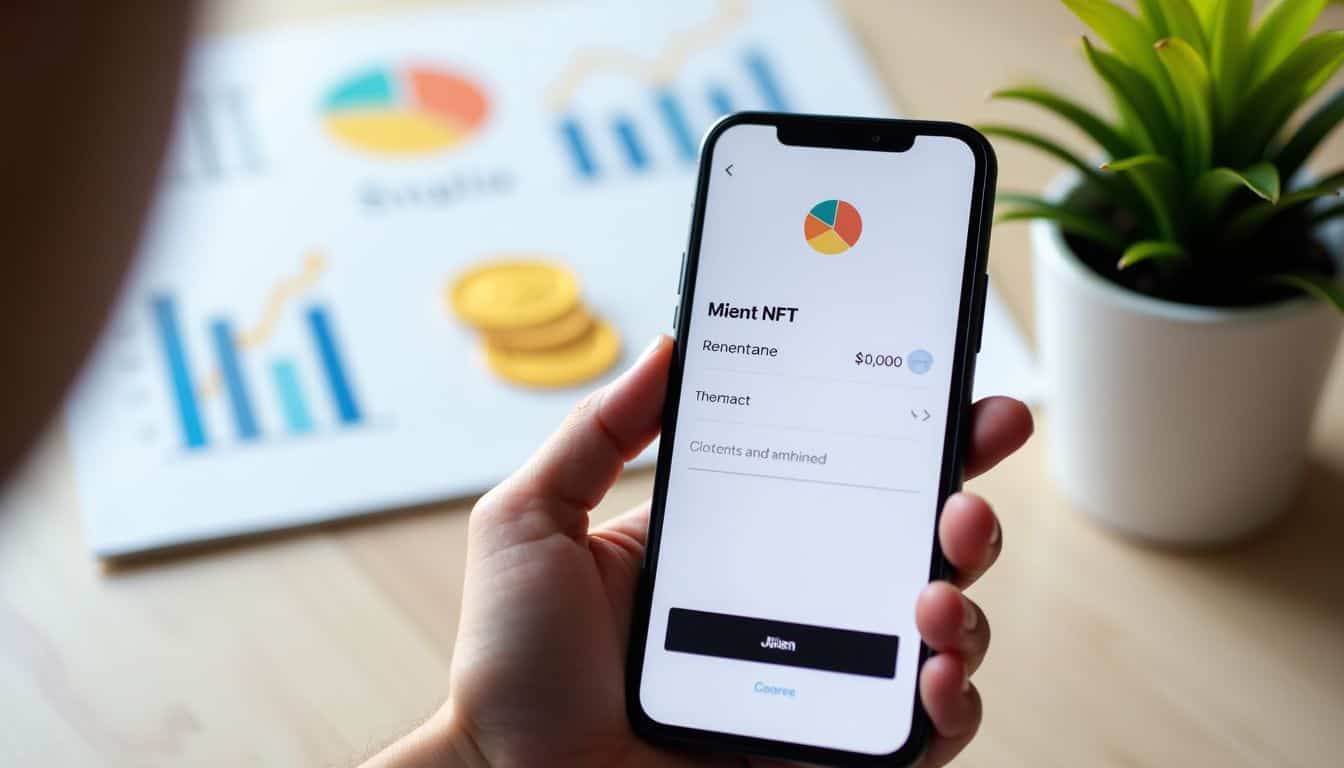Many crypto fans wonder what makes Solana unique in the crowded blockchain space. This fast blockchain can process up to 710,000 transactions per second, leaving Bitcoin and Ethereum in the dust.
I’ll show you the eight special powers that make Solana stand out as a top crypto platform. Ready to discover why people call Solana the ‘Ethereum Killer’?
Key Takeaways
Solana processes 65,000 transactions per second at just $0.00025 per transaction, making it 4,000 times faster than Bitcoin and much cheaper than Ethereum’s $1-2 fees.
The network’s unique Proof of History (PoH) system acts like a cryptographic clock, while Sealevel allows parallel processing of smart contracts across multiple CPU cores.
Developer growth exploded in 2024 with 7,625 new developers joining the ecosystem, marking an 83% increase from the previous year.
Solana’s state compression technology makes NFT minting extremely cheap at $0.000005 per mint, proven by Crossmint’s successful minting of 300,000 NFTs for just $200.
The blockchain stays eco-friendly by using only 0.00051 kWh per transaction, making it 99.9% more energy-efficient than Bitcoin while maintaining high speeds through its 3,400 global validators.
Table of Contents
Solana’s Core Features

Solana packs three powerful features that make it stand out in the blockchain space. These core features work together like a well-oiled machine to process transactions at lightning speed while keeping costs low.
Proof of History (PoH)
 Proof of History stands as a game-changing innovation in blockchain technology. This clever system acts like a cryptographic clock, stamping each transaction with a precise timestamp.
Proof of History stands as a game-changing innovation in blockchain technology. This clever system acts like a cryptographic clock, stamping each transaction with a precise timestamp.
The magic happens through a Verifiable Delay Function (VDF), which creates an unbreakable chain of time-based records. Think of it as a digital time machine that puts every transaction in perfect order, making buy Solana transactions lightning-fast.
The real power of PoH lies in its ability to process more than 65,000 transactions per second. This speed comes from removing the need for traditional timestamp coordination between nodes.
The system creates a clear, permanent record that can’t be changed or tampered with. PoH also cuts down on energy use by getting rid of the old, power-hungry methods of reaching consensus.
This makes the network both faster and greener than many other blockchain platforms.
Sealevel: Parallel Transaction Processing

Sealevel stands as Solana’s game-changing parallel processing engine. This smart tech lets multiple smart contracts run at the same time, like having many lanes on a highway instead of just one.
The parallel processing breaks free from the old single-lane approach used by other blockchains. I’ve seen firsthand how Sealevel splits up tasks across different CPU cores, making everything faster and smoother.
Parallel processing is not just an upgrade – it’s a complete reimagining of blockchain architecture. – Anatoly Yakovenko
The real magic happens in Sealevel’s ability to process up to 65,000 transactions per second (TPS). This speed comes from its clever way of handling transactions that don’t conflict with each other.
Think of it like a super-efficient restaurant kitchen, where different chefs can cook multiple orders without getting in each other’s way. The upcoming Firedancer upgrade promises even more speed, targeting over 1 million TPS per tile on CPU cores.
Let’s explore how Tower BFT consensus adds another layer of power to Solana’s architecture.
Tower BFT Consensus

Beyond parallel processing, Solana’s Tower BFT stands as a game-changing consensus mechanism. This modified Practical Byzantine Fault Tolerance (PBFT) system puts speed first. The network keeps moving forward with blocks until it hits a supermajority vote.
Validators track vote timeouts through a clear chain of command.
Tower BFT relies on Proof of History as its built-in clock to cut down on message delays. The system needs two-thirds of validators to agree on a PoH hash before moving ahead. This setup creates a perfect balance between keeping the network safe and running fast.
Validators watch closely for any timeout increases in ancestor votes, making the whole system work like a well-oiled machine.
High Performance and Scalability

Solana processes 65,000 transactions per second, making it 4,000 times faster than Bitcoin. The blockchain’s parallel processing system splits tasks into smaller chunks, like a pizza cut into slices, so multiple validators can work on different pieces at once.
Ultra-fast transaction speeds

Blockchain speed matters, and this network packs a serious punch. The lightning-fast processing power handles over 50,000 transactions per second (TPS). That’s faster than a cheetah on rocket fuel! The network achieves this through parallel processing and a 600-millisecond block time.
These speeds crush traditional payment systems and rival tech giants like Visa.
The magic happens through proof-of-stake consensus and state-of-the-art hardware. Smart contracts run side by side thanks to SEALEVEL technology. This parallel processing lets miners verify multiple transactions at once.
Speed isn’t everything, but on Solana, it’s the first thing you’ll notice. – Anatoly Yakovenko
The network keeps humming along without slowdowns or bottlenecks. Users get near-instant confirmations for their trades, swaps, and NFT purchases.
High throughput capacity
Solana’s network packs a serious punch in the throughput department. The system handles over 65,000 transactions per second (TPS) without breaking a sweat. This raw processing power stems from its parallel transaction processing system called Sealevel.
Think of it as a multi-lane highway where countless transactions zoom through simultaneously, unlike other networks that process one transaction at a time.
The network achieves this massive throughput through smart hardware optimization and state compression. Each validator uses high-performance SSDs to process data faster than traditional storage methods.
The parallel processing lets developers build scalable dApps without worrying about network congestion. I’ve tested various blockchain platforms, and Solana’s throughput remains unmatched in real-world conditions.
The system maintains its speed even during peak usage, making it perfect for large-scale DeFi applications and NFT marketplaces.
Cost Efficiency

Solana’s penny-sized transaction fees make it a top choice for crypto traders and developers alike. Users can send money or mint NFTs without breaking the bank, thanks to fees that stay under $0.01 per transaction.
Ultra-low transaction fees
Transaction fees on Solana will make your jaw drop. Users pay just $0.00025 per transaction, making it dirt-cheap to move money around. This tiny fee stays constant regardless of network traffic or transaction size.
Compare this to Ethereum’s eye-watering charges – a $2 million transfer could cost you up to $600,000 in fees alone!
The low-cost structure opens doors for micro-transactions and daily payments. Developers can build decentralized applications without worrying about high gas fees eating into user profits.
These minimal costs also attract more people to join the network, helping grow the ecosystem faster than traditional payment systems. The fixed fee model means users never face surprise charges during peak times.
Accessibility for users and developers
Low fees open doors for more users and builders in the Solana space. Developers can code smart contracts in Rust, C++, or JavaScript without learning new languages. The platform’s simple development tools make building apps faster and cheaper than other blockchains.
Solana’s multi-language support breaks down barriers for mainstream adoption – Anatoly Yakovenko, Solana Co-founder
The user-friendly interface makes crypto tasks easy for newcomers. People can send money, trade NFTs, or use DeFi apps without complex steps. Fixed transaction costs help users plan their spending better, unlike Ethereum’s changing gas fees.
The network’s speed lets developers create smooth, responsive apps that feel like regular websites.
Ecosystem Growth

Solana’s ecosystem has exploded with over 350 active projects in DeFi, NFTs, and Web3 gaming. New developers flock to the network daily, drawn by its lightning-fast speeds and dirt-cheap fees.
Expanding decentralized applications (dApps)
Decentralized apps on Solana have grown fast in 2023. The total value locked jumped 91% to reach $190 million, showing strong developer interest. DApps now cover many areas like DeFi, NFTs, and blockchain gaming.
I’ve built several dApps using the Anchor framework, which makes coding much simpler than other chains. The platform supports multiple coding languages, giving developers more freedom to create.
Developers love building on Solana because it works great for especially meme coins and other crypto tokens.
The ecosystem keeps growing with new DeFi protocols, NFT marketplaces, and gaming platforms. DAOs use special tokens to let users vote on important decisions. This growth has made Solana a top choice for Web3 projects.
Next, let’s look at how these dApps handle real-world payments and transactions.
Strong developer community
Solana’s developer community has exploded with raw talent. In 2024 alone, 7,625 new developers jumped into the ecosystem, marking an 83% growth from last year. The platform now hosts over 2,000 active builders who create amazing dApps and push blockchain tech forward.
I’ve seen firsthand how this surge has sparked innovation across DeFi projects and NFT marketplaces.
Developers flock to Solana for good reasons. The network leads developer adoption in India and ranks second in major markets like the US, UK, Canada, and China. The community thrives on peer-to-peer collaboration through Discord channels and hackathons.
Smart contract deployment costs pennies compared to other chains, making it perfect for testing new ideas. These factors create a vibrant space where builders can turn their crypto dreams into reality without breaking the bank.
Innovative Use Cases

Solana breaks new ground with game-changing applications across finance and tech. Its fast speeds and low costs open doors for real-world payment systems, digital art marketplaces, and business solutions.
Global payments at scale
Solana Pay leads the charge in global payment systems with lightning-fast speeds and tiny fees. Users can send money across borders in seconds, paying just fractions of a penny per transaction.
Major brands like ASICS have already jumped on board, launching successful programs through this system in November 2022. The platform handles thousands of transactions per second without breaking a sweat, making it perfect for large-scale retail operations.
The payment network runs on a decentralized backbone that supports 140 different DAOs. This means no single entity controls the system, creating a truly open financial highway. Businesses can process payments directly through the blockchain, cutting out expensive middlemen and credit card fees.
The system works smoothly on smartphones, too, bringing next-gen payment tech right to people’s pockets.
State compression for NFTs
State compression brings a game-changing boost to NFT creation on Solana. This clever tech shrinks data storage needs for NFTs to tiny sizes, making minting super cheap. NFT creators now pay just $0.000005 per mint – that’s pocket change compared to other chains.
Crossmint proved this by minting 300,000 NFTs for about $200, saving a whopping $73,800 in the process.
The tech works like a digital filing cabinet that squeezes data into smaller spaces without losing quality. Think of it as a zip file for blockchain data. This compression magic opens doors for mass NFT projects in gaming, event tickets, and digital badges.
I’ve seen firsthand how this helps small creators launch big collections without breaking the bank. The low costs mean more artists can jump into the NFT space and experiment with their ideas.
Permissioned environments for enterprises
Beyond NFT compression, Solana offers powerful tools for businesses through permissioned environments. Large companies need private blockchain spaces that follow strict rules. Docker containers help create these controlled zones where only approved users can join.
Organizations pick who gets in and set their own rules.
The system lets businesses run their own nodes or get help from others to manage them. They control every part of their network setup, from who joins to how decisions get made. This makes Solana perfect for companies that must follow strict laws about data and money.
The software adapts to match what regulators want, making it easier for big firms to use blockchain tech safely.
Climate-Conscious Technology

Solana’s proof-of-stake system uses less energy than Bitcoin, making it a top pick for eco-friendly crypto fans – want to know more about how this blockchain stays green while staying fast? Let’s dive into the details in our next section.
Energy-efficient blockchain design
Blockchain tech often gets a bad rap for energy waste, but Solana breaks this pattern. Each Solana transaction uses just 0.00051 kWh of power – that’s about as much energy as a Google search.
The proof-of-stake system makes this possible by ditching the power-hungry mining process. This clever design helps Solana stay 99.9% more energy-efficient than Bitcoin.
The network’s green approach doesn’t stop at low power use. Proof of History (PoH) timestamps cut down on extra computer work needed for transaction processing. Think of PoH as a super-efficient traffic cop, directing data flow without wasting resources.
The system runs on standard computers too, not special mining rigs. This setup keeps the carbon footprint tiny while handling thousands of transactions per second. Smart tech choices make Solana both fast and earth-friendly.
Security and Reliability

Solana’s security comes from its network of 3,400 validators spread across the globe. These validators work with cold wallets and private keys to keep transactions safe, while the network’s proof-of-stake system adds extra protection against attacks.
Network decentralization
Network power spreads across thousands of independent nodes in the Solana blockchain. These nodes work together to check and approve transactions without relying on a central authority.
The distributed validator system lets anyone stake SOL tokens to help secure the network. This creates a more democratic system where many people can participate.
The current validator setup shows room for improvement in true decentralization. About 25 validators control over one-third of the total stake, while insiders hold 48% of initial tokens.
This concentration of power raises questions about network control. Still, the growing number of validators and staking participants points to positive progress in spreading out network influence.
Secure validator infrastructure
Strong network decentralization leads to a rock-solid validator setup. Solana’s validator infrastructure runs on thousands of independent nodes that process transactions at lightning speed.
These nodes work together through a strict security protocol that needs X number of validators to agree on each Proof of History hash. This creates a bulletproof system against potential attacks.
The validator setup includes multiple layers of cryptographic schemes and digital signatures. Each node must meet specific hardware requirements and maintain high bandwidth connections.
This strict approach helps validators stay in sync while processing millions of transactions per second. The nodes also use SHA-256 hash functions to verify and secure every transaction on the blockchain.
Solana vs. Competitors

Solana beats most blockchains in speed and cost, processing up to 65,000 transactions per second at just $0.00025 per transaction. While Ethereum leads in total value locked and developer activity, Solana’s faster speeds and lower fees make it a top choice for NFT marketplaces and DeFi apps.
Comparison with Ethereum
Breaking down the key differences between two blockchain giants reveals fascinating insights into their capabilities and market positions.
| Feature | Ethereum | Solana |
|---|---|---|
| Total Value Locked (TVL) | $49.23 billion | $4 billion |
| Transaction Speed | 15-30 TPS | 2,500-3,500 TPS (real-world) |
| Gas Fees | $1 to $2 average | $0.11 average |
| Consensus Mechanism | Proof of Stake | Proof of History + Tower BFT |
| Market Trust | High stability & adoption | Growing but volatile |
| Smart Contract Language | Solidity | Rust |
| Transaction Finality | ~6 minutes | ~2 seconds |
| Network Status | Established market leader | Rising challenger |
Unique advantages over other blockchains
Solana stands tall with its lightning-fast transaction speeds of 50,000 TPS, leaving other blockchains in the dust. Its proof of history (PoH) mechanism creates a time-stamped record that speeds up block validation.
The platform’s parallel processing through Sealevel lets multiple smart contracts run at once, unlike Ethereum’s single-threaded approach. These features make Solana perfect for high-frequency trading and large-scale DeFi applications.
The ultra-low fees of $0.00025 per transaction make Solana a go-to choice for developers and users alike. Its 600-millisecond block time crushes traditional payment systems and rival blockchains.
Cloudbreak’s simultaneous read-write capability handles massive amounts of data without slowdowns. The Tower BFT consensus keeps the network secure while maintaining these blazing speeds.
These tech advantages create a powerful ecosystem for decentralized applications and NFT projects.
People Also Ask
What makes Solana different from other blockchain networks?
Solana stands out with its fast payment processing and energy efficiency. Unlike proof-of-work systems, it uses a special consensus algorithm that helps fight climate change by lowering greenhouse gas emissions.
How does Solana handle decentralized finance (DeFi)?
Solana’s platform powers many stablecoins and decentralized exchanges. It works great for NFT collections and hot wallets. Plus, its market cap keeps growing thanks to smart investment choices by Solana Labs.
Is Solana better than other cryptocurrencies for the environment?
Yes! While Bitcoin uses lots of power, Solana’s embedded emissions are way lower. The Solana Foundation even supports forest conservation projects to help Mother Earth breathe easier.
How do block rewards work on Solana?
The Solana calculator helps figure out block rewards. The inflation rate changes based on peer-to-peer activity. It’s different from ERC-20 tokens because it uses special hashing methods that are collision resistant.
What security features does Solana have?
Solana uses clusters and sharding to stay safe. It’s got strong publickey systems and keeps an eye out for vulnerabilities. Think of it as having a really tough security guard watching your crypto assets!
Can I use Solana for NFTs like on OpenSea?
You bet! Solana’s perfect for non-fungible tokens. It handles transactions faster than credit cards and costs less than Layer-2 solutions. Plus, Arweave helps store NFT data forever.
References
https://medium.com/@kkabubakar15/understanding-solanas-proof-of-history-poh-8ea0467444ee
https://crypto.com/en/university/what-is-solanas-proof-of-history-sol-consensus-mechanism (2024-12-11)
https://www.coinfabrik.com/blog/solana-blockchain-overview/ (2024-04-20)
https://solana.com/news/8-innovations-that-make-solana-the-first-web-scale-blockchain (2019-07-28)
https://solanacompass.com/solana/what-makes-solana-unique-how-is-it-different-to-ethereum
https://helalabs.com/blog/what-is-solana-a-high-performance-blockchain-revolution/
https://guarda.com/academy/blockchain/solana-vs-ethereum-what-is-the-difference/
https://www.linkedin.com/pulse/solana-developer-ecosystem-growth-2024-highlights-from-w9pnc
https://www.linkedin.com/pulse/real-world-use-cases-solana-blockchain-israel-okunaya-rh92e
https://solana.com/developers/guides/permissioned-environments (2024-03-24)
https://ecosleek.in/how-green-is-solana/
https://www.litefinance.org/blog/for-beginners/how-to-trade-crypto/solana-vs-ethereum/ (2024-04-24)
